Monday, March 27, 2017
Chris Hass, why should we pay your bills?
Chris Hass is the Deputy Publisher of IN THESE TIMES.
Has been for over a year now.
← Now deputy publisher @InTheseTimesMag, a political magazine that's been troublemaking & muckraking for 40 years. Will try not to f-it up.
0 replies2 retweets2 likes
You'd think that position paid a little.
Apparently not.
Hence, "We're trying something new" -- the mass e-mailing sent out yesterday to everyone ever foolish enough to provide their e-mail to IN THESE TIMES.
The e-mail opens with a "Hi" -- don't you love familiarity when someone's trying to slip their hand into your wallet? -- and then offers:
You get what you pay for, as the saying goes -- but when it comes to journalism, we don't pay for much anymore.
And as more and more readers get their news for free, too many outlets have shifted their focus to ad-supported content that competes for the most clicks, rather than the biggest impact.
It's a tragic irony of our time that just when we need bold, truth-telling journalism most, financial support for this kind of media has all but evaporated.
Between 2007 and 2015, the number of full-time journalists working at daily newspapers fell by 40 percent. More than 100 local newspapers closed in 2009 alone. Every day there are fewer reporters on the beat, and less investigative reporting being done.
At the same time, the past few months have seen a surge of interest in independent journalism that's willing to speak truth to power -- since November, In These Times has gained more than 15,000 new magazine subscribers.
That's a huge lift, and it's helped us come out of the gate strong this year with on-the-ground reporting on the growing resistance to the Trump administration, as well as deeply-researched pieces on the origin and forces behind Trumpism.
But to truly support the work of our reporters, and to produce the kind of journalism this moment demands, we can't keep riding the same boom and bust cycle that's been the reality for independent media for years now.
That's why we're trying something different. We're asking readers to invest in the kind of journalism they want to read, for the long-haul.
What does this mean? For readers, it means committing to make a small donation of just $5 or more each month -- about the cost of two cups of coffee. For our journalism however, it could be a game-changer.
No offense, Chris, we get that you're just doing your job.
But your e-mail is annoying and worse.
Exactly what did you do during the last eight years?
Did you challenge Barack Obama's bombings of Iraq?
Did you challenge his Drone War?
Did you report regularly on the ongoing Iraq War?
No.
No.
And no.
So what the fuck makes you think we owe a penny to IN THESE TIMES.
It was nothing but an organ for the Democratic Party.
It failed the left repeatedly.
It also failed to cover the ongoing wars.
You don't deserve a penny.
And before you beg next, why don't you do even one damn thing that qualifies as journalism?
We don't need your crap on how the Democratic Party's going to save us.
It hasn't so far, but keep telling that fairy tale to whatever children you can round up.
For those of us who have grown up, we realize that the failure of IN THESE TIMES would actually be liberating for the left -- leaving us one left fake ass outlet that does nothing.
Who doesn't love puppies?
March 23rd was National Puppy Day?
Who knew?
Not us.
But we love puppies.
So, apparently, does the US Department of Interior.
They shared the following:
Who knew?
Not us.
But we love puppies.
So, apparently, does the US Department of Interior.
They shared the following:
Nothing
is cuter than a puppy. But did you know that dogs aren’t the only
animals with pups? Other species (even some that are not members of the
canine family) have young that are also called pups. Many of these
animals can be found across our nation’s public lands. From wildlife
refuges and national monuments to wildernesses and national parks,
public lands provide a vital habitat for wildlife.
So on March 23 to celebrate National Puppy Day, we’re featuring some of our favorite pups that you can find on our public lands.
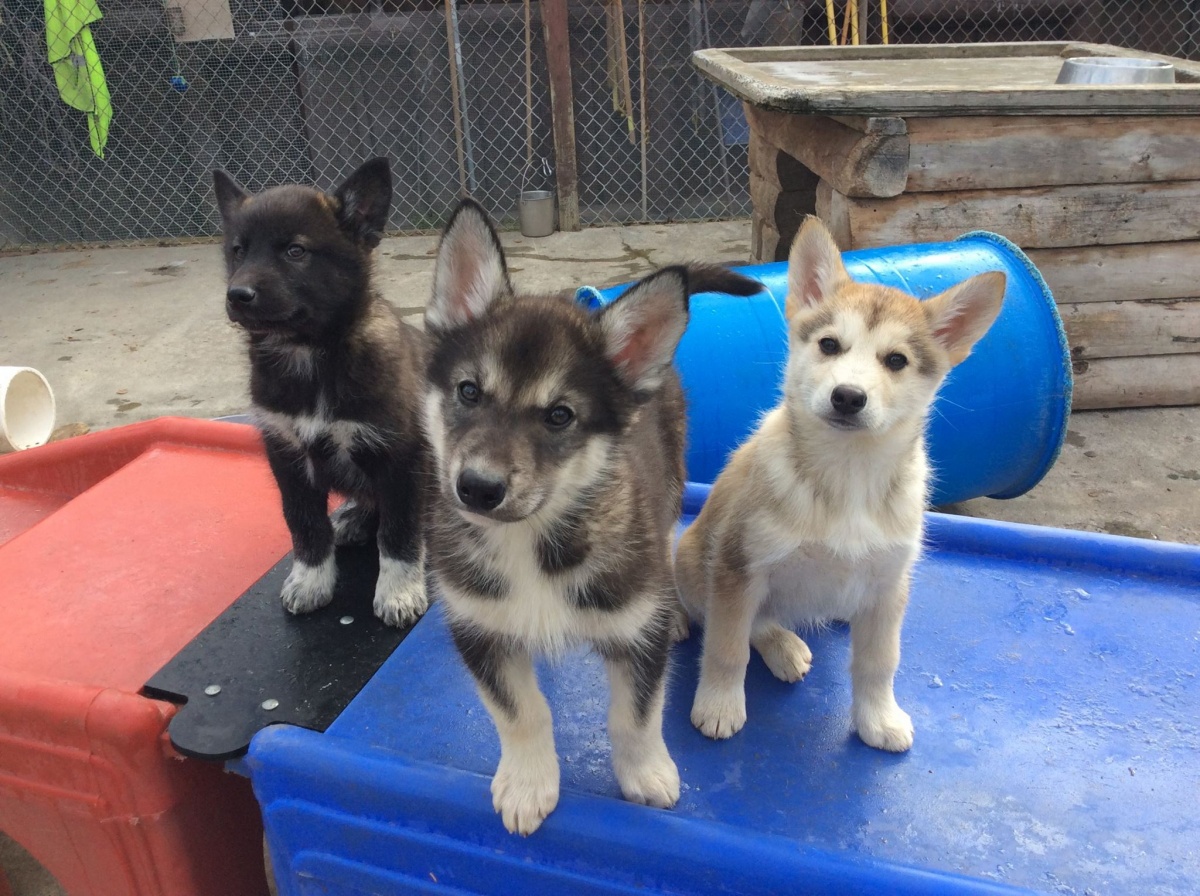
These cute pups are part of the sled dog team at Denali -- the only national park in the U.S. with working dogs. Sled dogs have an essential role in the life and culture of Alaska, and Denali’s team helps protect a national park and the wildlife, scenery and wilderness therein. Visit Denali’s website to meet the park’s canine rangers. This photo from last September shows three puppies -- Cupcake, Pinata, and Party -- in Denali’s “Birthday” litter. Photo by National Park Service.

Aww! This cute little otter pup is resting on its mother’s belly as she floats in calm waters. Sea otters breed and pup year-round, with usually one pup born every 1-2 years. Their larger size, flatter tail, and grayish head distinguish them from river otters. One of the few mammals observed to use tools, sea otters use rocks to break the shells of shellfish and mollusks. Sea otters are mostly found off the coast of Alaska, including at Glacier Bay National Park & Preserve. Photo courtesy of Randall Davis under U.S. Fish and Wildlife Service permit No. MA078744-4.
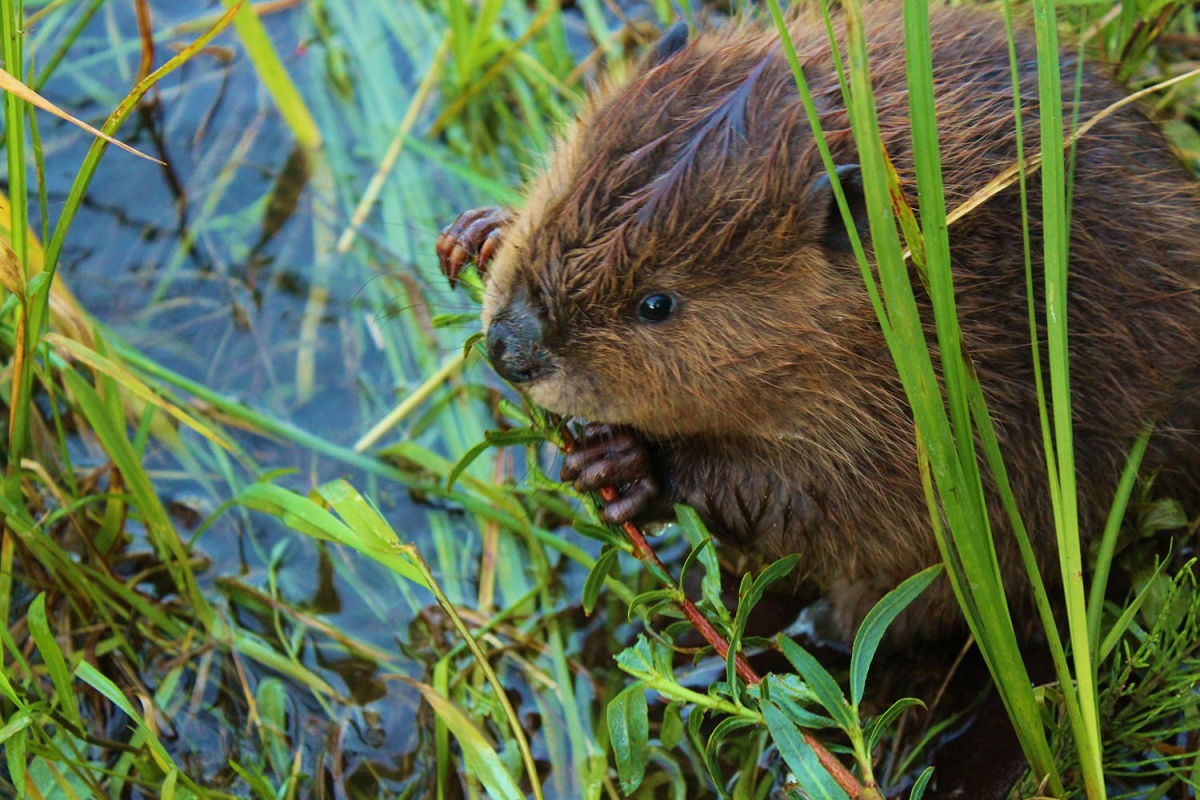
When they are first born, beaver pups are no larger than the size of your fist! The beaver is known for its flat tail that acts as a rudder, and its efficient ability to gnaw through wood. They live in colonies and remain with their mate for life, living about 8-10 years in the wild. Beavers are spread throughout North America, from Zion National Park in Utah to Colorado’s Rocky Mountain National Park to Voyageurs National Park in Minnesota. Learn more about the lumberjack of nature here. Photo of a baby beaver snacking on a stick by Tenise Kakuk (www.sharetheexperience.org).

Though mostly referred to as calves, baby dolphins are also sometimes called pups. Born after a 12-month gestation period, pups stay with their mothers for at least a year and a half, swimming with fellow members of their pod and learning a unique hunting style called “fish whacking.” Intelligent and playful, some species of dolphins can live to be 50 years old. You can find dolphins in Florida and throughout the Pacific Remote Islands, Rose Atoll, and Papahānaumokuākea Marine National Monuments. Photo of a pod of common dolphins by Lara Drizd, U.S. Fish and Wildlife Service.
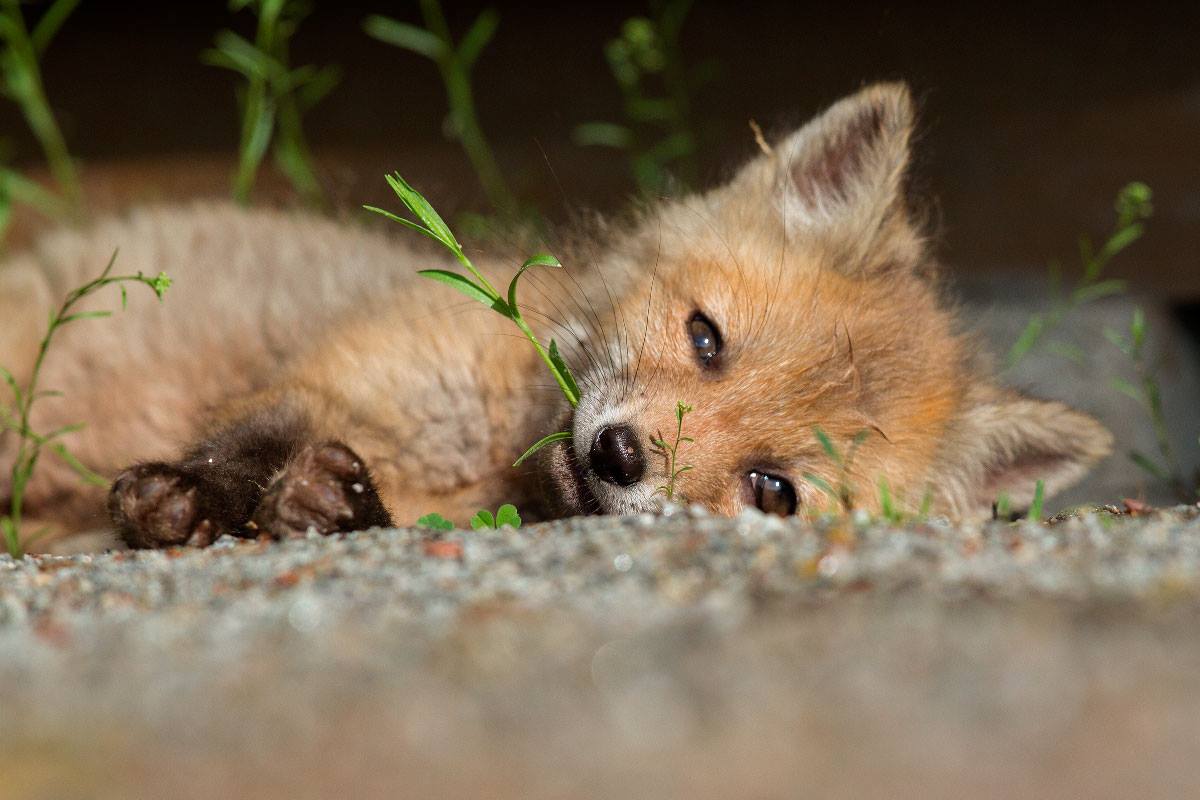
The red fox is a member of the canine family and can be found throughout the United States. In the spring, a mother fox gives birth to a litter of 2-12 pups (also called kits). When the pups are about seven months old, they’re ready to strike out on their own. By winter the pup will find a mate and will stay with that mate for the rest of their life. You can see fox pups across the U.S., like this one at Great Swamp National Wildlife Refuge in New Jersey. Learn more facts about red foxes on nps.gov. Photo by Ashleigh Scully via U.S. Fish & Wildlife Service.
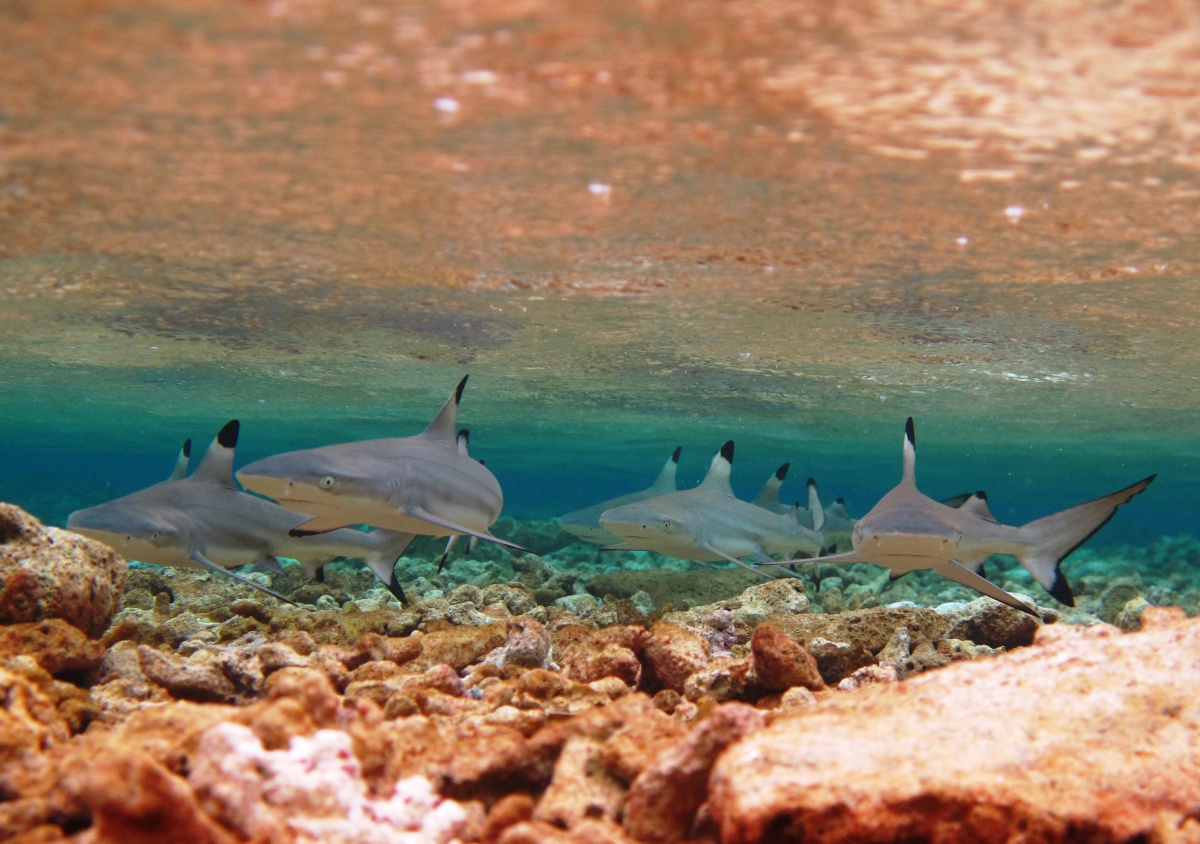
Though they may look like they are living large, these blacktip reef shark puppies are less than a foot long. Female blacktip reef sharks are one of the species of sharks that give birth to live young (other shark species are hatched out of eggs). Most litters contain two to four pups. These baby blacktip reef sharks are basking in the shallow lagoon protected by Palmyra Atoll National Wildlife Refuge in the Pacific Remote Islands Marine National Monument. The coral reefs surrounding Palmyra Atoll are part of an apex predator dominated ecosystem -- where sharks are king. Photo by Amanda Pollock, U.S. Fish and Wildlife Service.
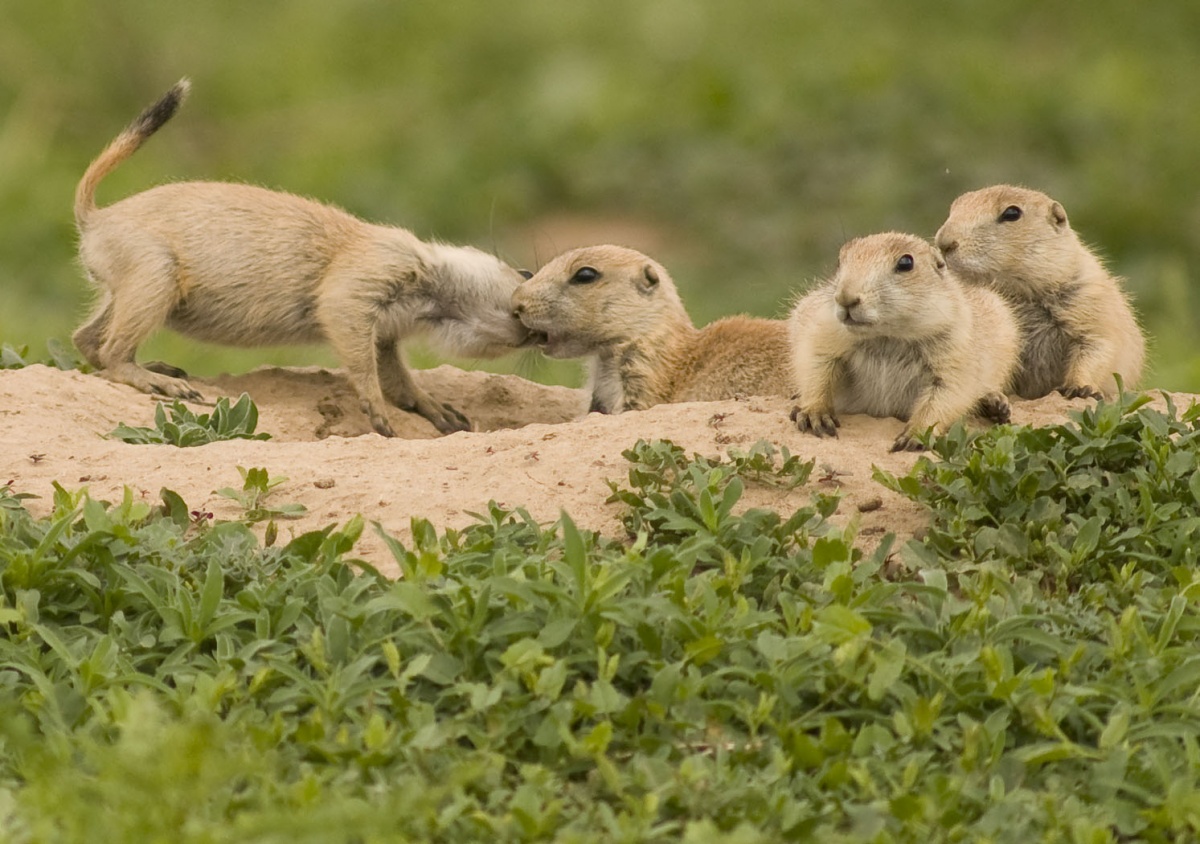
Look at these cute prairie dog pups! Though related to squirrels and not part of the canine family despite their name, prairie dogs bark like dogs. Fully grown at five months, pups live with their families in underground burrows which are often linked together to form large colonies or “towns.” Highly social, they have a variety of calls and also interact by “kissing” and grooming each other. Prairie dog mothers give birth to litters of 1 to 8 pups in April or May of each year. Look for the pups playing around their burrows at Colorado’s Rocky Mountain Arsenal National Wildlife Refuge in the spring, like these guys. Photo by Rich Keen, DRPA.
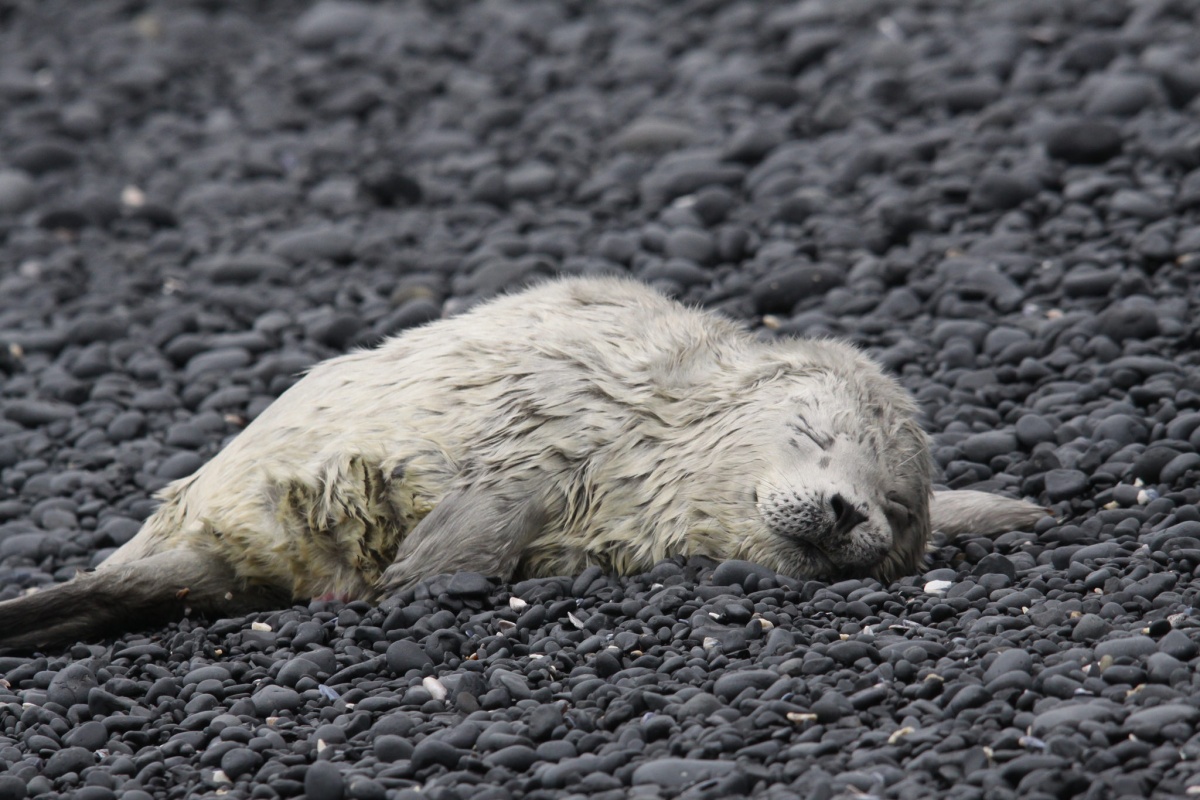
With many different species of seals living along the world’s coasts, these animals display an amazing variety of size and behavior. However, they all have something in common: really cute pups. Mostly born during the spring and summer months, seal pups are completely helpless and require a great deal of attention and protection from their mothers. This photo of a seal pup was taken at Yaquina Head Outstanding Natural Area, which extends out from the Oregon coast into the Pacific Ocean. The offshore islands are a year-round refuge for harbor seals. Photo by Bureau of Land Management.
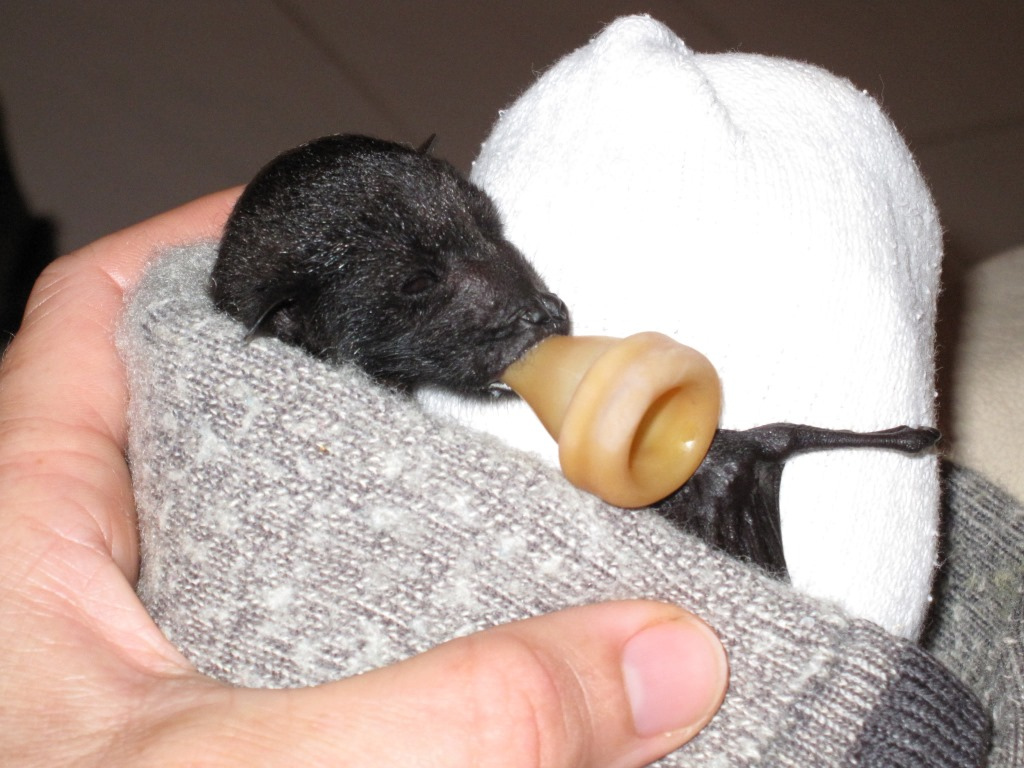
Bats can be found on nearly every part of the planet, and they come in all shapes and sizes. Most bats only give birth to one baby annually, and a pup can stay near its mother for up to a year. Like other mammals, mother bats feed their pups breastmilk, and will wrap baby bats in their wings for warmth and comfort. Pictured here is an orphaned baby Marianas fruit bat, which is found only on Guam and the Commonwealth of the Northern Mariana Islands. Guam National Wildlife Refuge provides a safe haven for this endangered species. Check out more interesting facts about bats on DOI.gov. Photo by U.S. Fish and Wildlife Service.
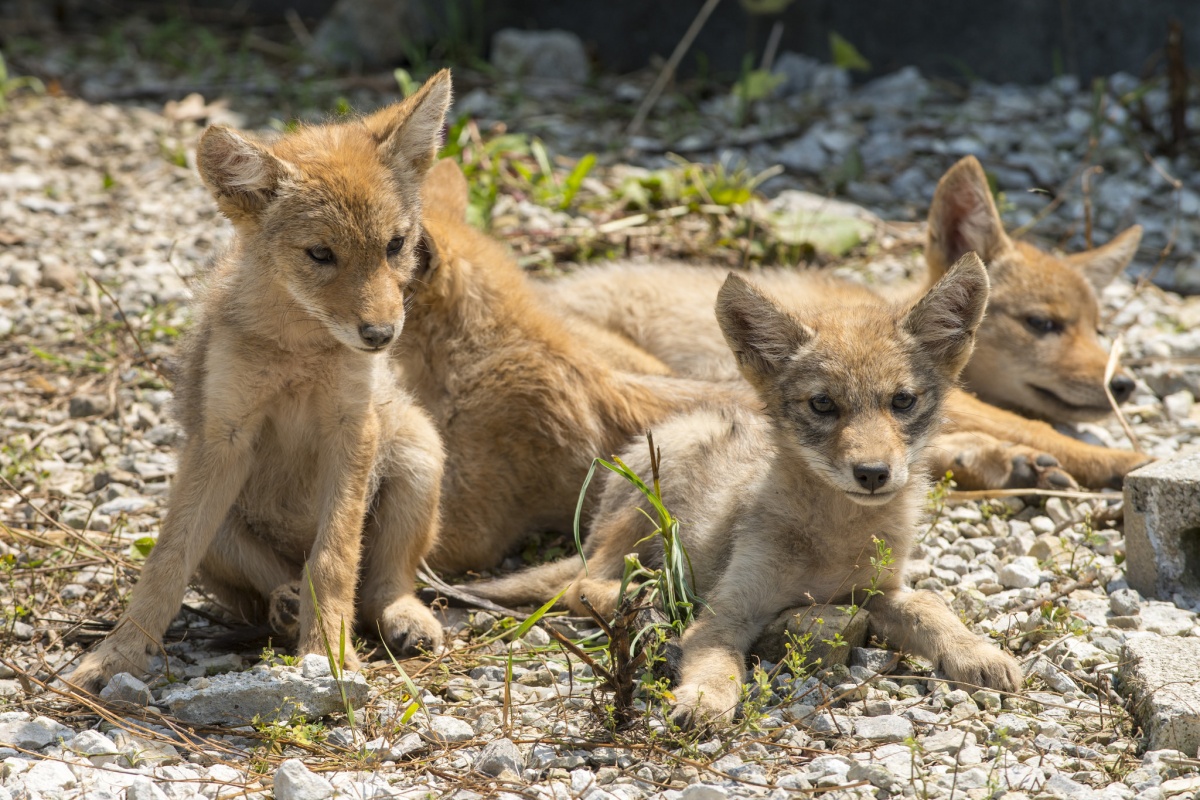
Although they are known for travelling alone or in pairs, coyotes are able to form significant family bonds. Often male and female coyotes will pair off and remain together for several years, establishing dens and mating between January and March. When a coyote pup is born, it is both hairless and sightless and will typically open its eyes after 10 days and will not leave the den until about 8-10 weeks of age. Coyote pups also love play fighting, and they begin at an early age to develop hunting skills. Wild sanctuaries like Rocky Mountain National Park allow coyotes to roam undisturbed. They can be spotted frequently during the daytime hours, and heard howling at night. Park visitors should never approach a coyote or pups, or disturb an active den site. Photo of coyote pups at Fermilab by the Department of Energy.
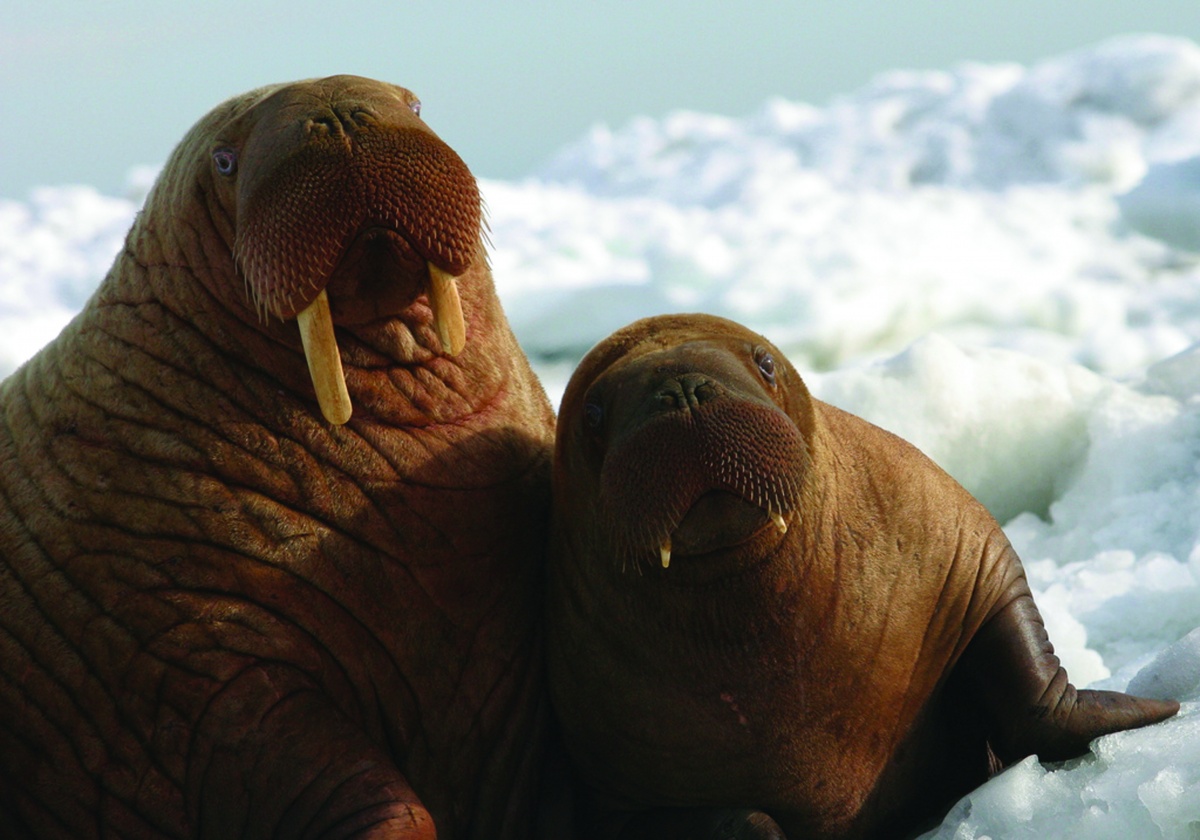
Walrus pups are able to swim at birth and weigh between 100 and 150 pounds. Most are only children (twin births are rare), and they stay with their mothers for two years. Eventually, their small young tusks will grow up to three feet long. Hunted for that precious ivory, walrus populations dropped rapidly in the 19th and 20th century, but have since started to rebound. Learn more about the Pacific walrus in Alaska. Photo of a Pacific walrus and its pup by U.S. Fish and Wildlife Service.
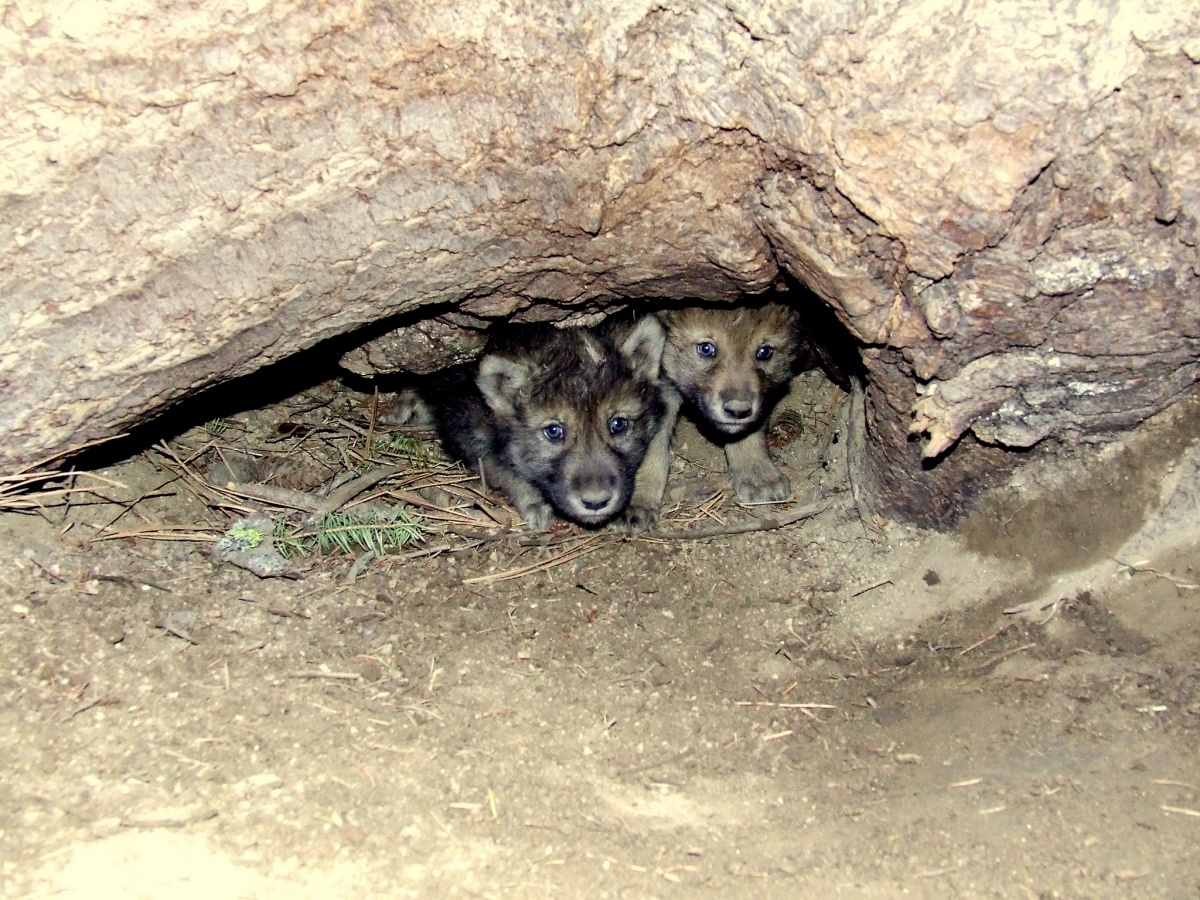
These gray wolf pups, usually born in April with a litter size of 4-5, emerge from the den 10-14 days after birth. A male pup can grow to about 100-130 pounds and females range from 80-110 pounds. Most active at dawn and dusk, wolves usually prey on young or weak animals and use their distinctive howl to communicate. If you’re lucky, you might see a wolf while visiting Yellowstone National Park. Photo by Hilary Cooley, U.S. Fish and Wildlife Service.
So on March 23 to celebrate National Puppy Day, we’re featuring some of our favorite pups that you can find on our public lands.
Dog Pup

These cute pups are part of the sled dog team at Denali -- the only national park in the U.S. with working dogs. Sled dogs have an essential role in the life and culture of Alaska, and Denali’s team helps protect a national park and the wildlife, scenery and wilderness therein. Visit Denali’s website to meet the park’s canine rangers. This photo from last September shows three puppies -- Cupcake, Pinata, and Party -- in Denali’s “Birthday” litter. Photo by National Park Service.
Otter Pup

Aww! This cute little otter pup is resting on its mother’s belly as she floats in calm waters. Sea otters breed and pup year-round, with usually one pup born every 1-2 years. Their larger size, flatter tail, and grayish head distinguish them from river otters. One of the few mammals observed to use tools, sea otters use rocks to break the shells of shellfish and mollusks. Sea otters are mostly found off the coast of Alaska, including at Glacier Bay National Park & Preserve. Photo courtesy of Randall Davis under U.S. Fish and Wildlife Service permit No. MA078744-4.
Beaver Pup

When they are first born, beaver pups are no larger than the size of your fist! The beaver is known for its flat tail that acts as a rudder, and its efficient ability to gnaw through wood. They live in colonies and remain with their mate for life, living about 8-10 years in the wild. Beavers are spread throughout North America, from Zion National Park in Utah to Colorado’s Rocky Mountain National Park to Voyageurs National Park in Minnesota. Learn more about the lumberjack of nature here. Photo of a baby beaver snacking on a stick by Tenise Kakuk (www.sharetheexperience.org).
Dolphin Pup

Though mostly referred to as calves, baby dolphins are also sometimes called pups. Born after a 12-month gestation period, pups stay with their mothers for at least a year and a half, swimming with fellow members of their pod and learning a unique hunting style called “fish whacking.” Intelligent and playful, some species of dolphins can live to be 50 years old. You can find dolphins in Florida and throughout the Pacific Remote Islands, Rose Atoll, and Papahānaumokuākea Marine National Monuments. Photo of a pod of common dolphins by Lara Drizd, U.S. Fish and Wildlife Service.
Fox Pup

The red fox is a member of the canine family and can be found throughout the United States. In the spring, a mother fox gives birth to a litter of 2-12 pups (also called kits). When the pups are about seven months old, they’re ready to strike out on their own. By winter the pup will find a mate and will stay with that mate for the rest of their life. You can see fox pups across the U.S., like this one at Great Swamp National Wildlife Refuge in New Jersey. Learn more facts about red foxes on nps.gov. Photo by Ashleigh Scully via U.S. Fish & Wildlife Service.
Shark Pup

Though they may look like they are living large, these blacktip reef shark puppies are less than a foot long. Female blacktip reef sharks are one of the species of sharks that give birth to live young (other shark species are hatched out of eggs). Most litters contain two to four pups. These baby blacktip reef sharks are basking in the shallow lagoon protected by Palmyra Atoll National Wildlife Refuge in the Pacific Remote Islands Marine National Monument. The coral reefs surrounding Palmyra Atoll are part of an apex predator dominated ecosystem -- where sharks are king. Photo by Amanda Pollock, U.S. Fish and Wildlife Service.
Prairie Dog Pup

Look at these cute prairie dog pups! Though related to squirrels and not part of the canine family despite their name, prairie dogs bark like dogs. Fully grown at five months, pups live with their families in underground burrows which are often linked together to form large colonies or “towns.” Highly social, they have a variety of calls and also interact by “kissing” and grooming each other. Prairie dog mothers give birth to litters of 1 to 8 pups in April or May of each year. Look for the pups playing around their burrows at Colorado’s Rocky Mountain Arsenal National Wildlife Refuge in the spring, like these guys. Photo by Rich Keen, DRPA.
Seal Pup

With many different species of seals living along the world’s coasts, these animals display an amazing variety of size and behavior. However, they all have something in common: really cute pups. Mostly born during the spring and summer months, seal pups are completely helpless and require a great deal of attention and protection from their mothers. This photo of a seal pup was taken at Yaquina Head Outstanding Natural Area, which extends out from the Oregon coast into the Pacific Ocean. The offshore islands are a year-round refuge for harbor seals. Photo by Bureau of Land Management.
Bat Pup

Bats can be found on nearly every part of the planet, and they come in all shapes and sizes. Most bats only give birth to one baby annually, and a pup can stay near its mother for up to a year. Like other mammals, mother bats feed their pups breastmilk, and will wrap baby bats in their wings for warmth and comfort. Pictured here is an orphaned baby Marianas fruit bat, which is found only on Guam and the Commonwealth of the Northern Mariana Islands. Guam National Wildlife Refuge provides a safe haven for this endangered species. Check out more interesting facts about bats on DOI.gov. Photo by U.S. Fish and Wildlife Service.
Coyote Pup

Although they are known for travelling alone or in pairs, coyotes are able to form significant family bonds. Often male and female coyotes will pair off and remain together for several years, establishing dens and mating between January and March. When a coyote pup is born, it is both hairless and sightless and will typically open its eyes after 10 days and will not leave the den until about 8-10 weeks of age. Coyote pups also love play fighting, and they begin at an early age to develop hunting skills. Wild sanctuaries like Rocky Mountain National Park allow coyotes to roam undisturbed. They can be spotted frequently during the daytime hours, and heard howling at night. Park visitors should never approach a coyote or pups, or disturb an active den site. Photo of coyote pups at Fermilab by the Department of Energy.
Walrus Pup

Walrus pups are able to swim at birth and weigh between 100 and 150 pounds. Most are only children (twin births are rare), and they stay with their mothers for two years. Eventually, their small young tusks will grow up to three feet long. Hunted for that precious ivory, walrus populations dropped rapidly in the 19th and 20th century, but have since started to rebound. Learn more about the Pacific walrus in Alaska. Photo of a Pacific walrus and its pup by U.S. Fish and Wildlife Service.
Wolf Pup

These gray wolf pups, usually born in April with a litter size of 4-5, emerge from the den 10-14 days after birth. A male pup can grow to about 100-130 pounds and females range from 80-110 pounds. Most active at dawn and dusk, wolves usually prey on young or weak animals and use their distinctive howl to communicate. If you’re lucky, you might see a wolf while visiting Yellowstone National Park. Photo by Hilary Cooley, U.S. Fish and Wildlife Service.
Tweet of the week (domestic)
.@TheDemocrats via @MoveOn coopted the peace movement a decade ago. So expect zero #Resistance to their warmongering
0 replies3 retweets2 likes
This edition's playlist

2) Neil Young's STORYTONE.
3) Aretha Franklin's ARETHA SINGS THE GREAT DIVA CLASSICS.
4) Cloud Nothing's HERE AND NOWHERE ELSE.
5) John Lennon's SOME TIME IN NEW YORK CITY.
6) Sade's LOVER'S ROCK.
7) Animal Collective's CENTIPEDE HZ.
8) Joni Mitchell's DOG EAT DOG.
9) Janet Jackson's UNBREAKABLE.
10) Ben Harper and Ellen Harper's CHILDHOOD HOME.
Monday, March 20, 2017
Truest statement of the week
What is a Deep State? The U.S. Deep State is unlike any other, in
that there is no other global superpower bent on world domination. (Washington’s
political posture is also unique; no other nation claims to be
“exceptional” and “indispensable” and thus not subject to the
constraints of international law and custom.) Indeed, the U.S. is so
proudly and publicly imperialist that much of what should be secret
information about U.S. military and other capabilities is routinely fed
to the world press, such as the 2011 announcement that the U.S. now has a
missile that can hit any target on the planet in 30 minutes, part of
the Army’s “Prompt Global Strike” program. Frightening the rest of the world into submission -- a form of global terrorism -- is U.S. public policy.
However, arming and training Islamic jihadist terrorists to subvert internationally recognized governments targeted by the U.S. for regime change is more than your usual variety of covert warfare: It is a policy that must forever be kept secret, because U.S. society would suffer a political breakdown if the facts of U.S. and Saudi nurturing of the international jihadist network were ever fully exposed. This is Deep State stuff of the highest order. The true nature of U.S. foreign policy in the 21st century, and the real character of the current wars in Syria and Iraq, must be hidden from the U.S. public at all cost. An alternative reality must be presented, through daily collaboration between corporate media, corporate universities, and the public and covert organs of the U.S. State.
What part of the New York Times coverage of the war against Syria is a lie? Damn near all of it. What role does the Deep State play in crafting the lies dutifully promulgated by the corporate media? That’s impossible to answer, because the Deep State is a network of relationships, not a clearly delineated zone or space or set of organizations. The best way to describe the imperial Deep State is: those individuals and institutions that are tasked with establishing the global supremacy of the corporate ruling class. Such activities must be masked, since they clash with the ideological position of the ruling class, which is that the bourgeois electoral system of the United States is the world’s freest and fairest. The official line is that the U.S. State is a work of near-perfection, with checks and balances that prevent any class, group or section from domination over the other. The truth is that an oligarchy rules, and makes war on whomever it chooses -- internationally and domestically -- for the benefit of corporate capital.
Glen Ford, "The U.S. Deep State Rules – On Behalf of the Ruling Class" (BLACK AGENDA REPORT).
However, arming and training Islamic jihadist terrorists to subvert internationally recognized governments targeted by the U.S. for regime change is more than your usual variety of covert warfare: It is a policy that must forever be kept secret, because U.S. society would suffer a political breakdown if the facts of U.S. and Saudi nurturing of the international jihadist network were ever fully exposed. This is Deep State stuff of the highest order. The true nature of U.S. foreign policy in the 21st century, and the real character of the current wars in Syria and Iraq, must be hidden from the U.S. public at all cost. An alternative reality must be presented, through daily collaboration between corporate media, corporate universities, and the public and covert organs of the U.S. State.
What part of the New York Times coverage of the war against Syria is a lie? Damn near all of it. What role does the Deep State play in crafting the lies dutifully promulgated by the corporate media? That’s impossible to answer, because the Deep State is a network of relationships, not a clearly delineated zone or space or set of organizations. The best way to describe the imperial Deep State is: those individuals and institutions that are tasked with establishing the global supremacy of the corporate ruling class. Such activities must be masked, since they clash with the ideological position of the ruling class, which is that the bourgeois electoral system of the United States is the world’s freest and fairest. The official line is that the U.S. State is a work of near-perfection, with checks and balances that prevent any class, group or section from domination over the other. The truth is that an oligarchy rules, and makes war on whomever it chooses -- internationally and domestically -- for the benefit of corporate capital.
Glen Ford, "The U.S. Deep State Rules – On Behalf of the Ruling Class" (BLACK AGENDA REPORT).
Truest statement of the week II
Last week Physicians for a National Health Care Plan released a press
statement declaring the Republican plan to replace Obamacare “a
re-branded and far meaner version” of the 2010 Affordable Health Care
Act. This ought to raise a pertinent question: If all Republicans have
to do is “re-brand” and tweak Obamacare, was it really much good to
start with? The fact is that Obamacare was written by and for insurance
companies in the first place, and from the beginning it left out roughly
half the black uninsured, who lived in states where Republican
legislatures and governors were able to block Medicaid expansion. For many
of those who did receive coverage, high deductibles, co-insurance and
co-pays made using your new Obamacare policy unaffordable.
So why are Democratic special election candidates like Georgia’s Jon Ossoff whining that they want to work with Republicans to “fix what’s broken” in Obamacare, when the entire premise of trusting for-profit insurance companies to deliver health care is bankrupt and useless? The answer is that this is what Democrats do.
Bruce A. Dixon, "The Bright Lines: Who Will Fight For Medicare For All, Who Will Stand Against Militarism and Austerity? Not John Ossoff or Our Revolution." (BLACK AGENDA REPORT).
So why are Democratic special election candidates like Georgia’s Jon Ossoff whining that they want to work with Republicans to “fix what’s broken” in Obamacare, when the entire premise of trusting for-profit insurance companies to deliver health care is bankrupt and useless? The answer is that this is what Democrats do.
Bruce A. Dixon, "The Bright Lines: Who Will Fight For Medicare For All, Who Will Stand Against Militarism and Austerity? Not John Ossoff or Our Revolution." (BLACK AGENDA REPORT).
Subscribe to:
Posts (Atom)

